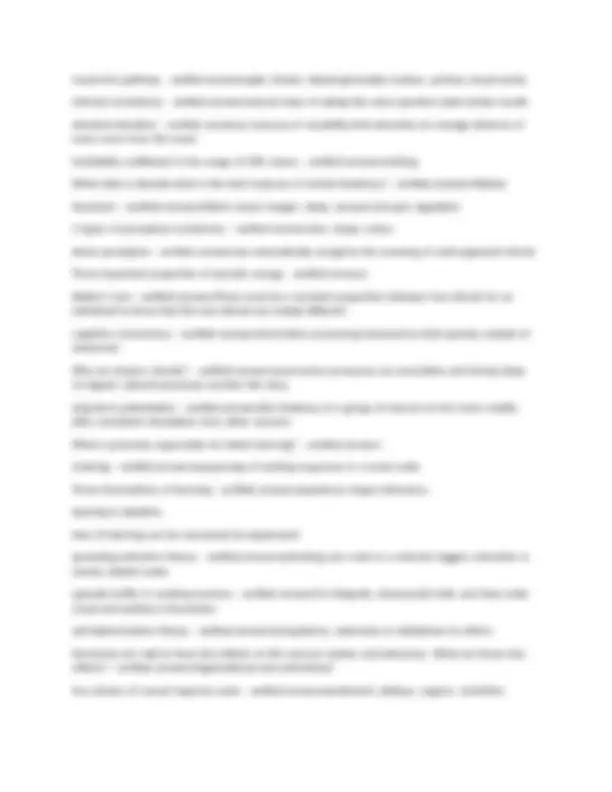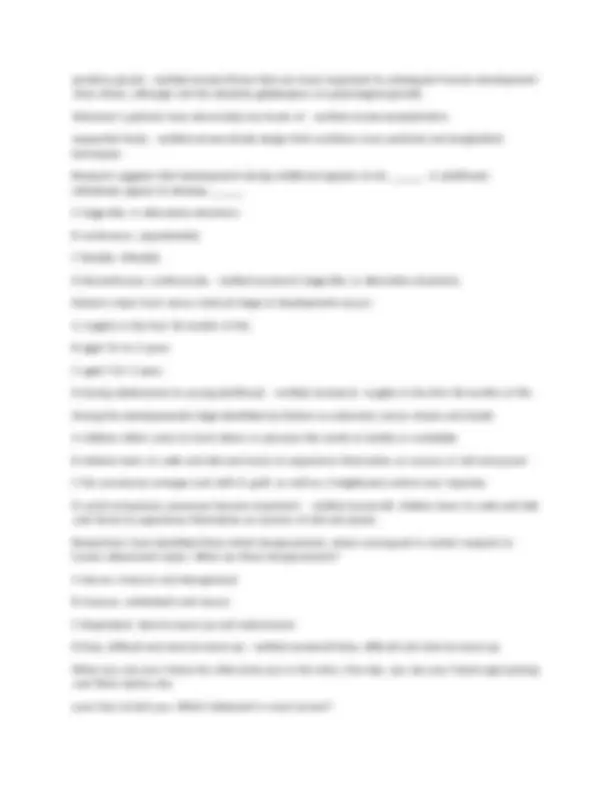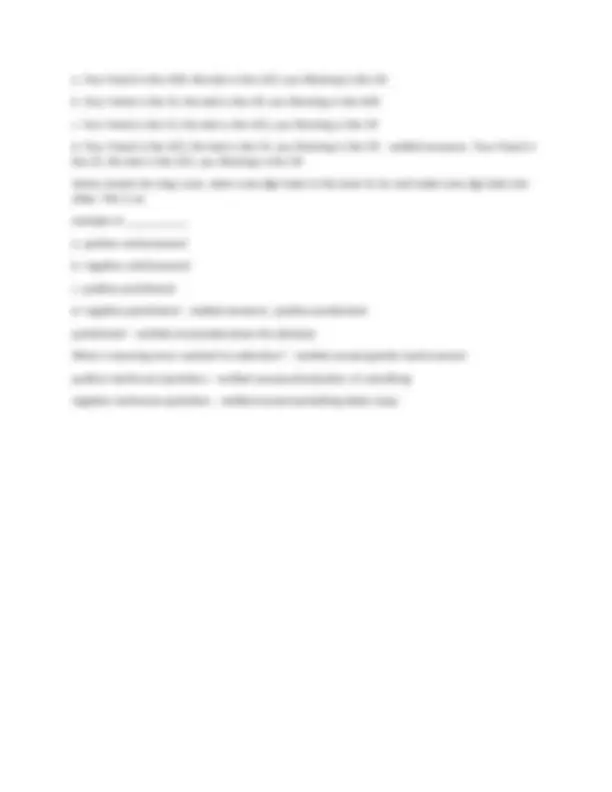





Study with the several resources on Docsity

Earn points by helping other students or get them with a premium plan


Prepare for your exams
Study with the several resources on Docsity

Earn points to download
Earn points by helping other students or get them with a premium plan
Community
Ask the community for help and clear up your study doubts
Discover the best universities in your country according to Docsity users
Free resources
Download our free guides on studying techniques, anxiety management strategies, and thesis advice from Docsity tutors
UNE PSYC101 Exam Revision Guide 2025 Verified Study
Typology: Exams
1 / 5

This page cannot be seen from the preview
Don't miss anything!




Expectancies |- |verified |answersbeliefs |about |our |ability |to |perform |an |action |and |to |get |the |desired | reward A |placebo |effect |- |verified |answersdepends |on |a |participants |belief |in |the |effectiveness |of |the | independent |variable What |is |the |primary |method |of |behaviourism? |- |verified |answersExperimental |method Reliability |in |a |Measurement |- |verified |answersis |the |measure's |tendency |to |give |the |same |result | from |one |occasion |to |the |next Three |principles |that |underlie |critical |thinking |- |verified |answersscepticism, |objectivity, |open- mindedness Testing |Hypothesis |- |verified |answerscontext |of |justification demand |characteristics |- |verified |answerscues |in |an |experiment |that |tell |the |participant |what | behavior |is |expected related |samples |t |test |- |verified |answersrepeated |measures |or |matched |subject independant |samples |t |test |- |verified |answerscompare |means |of | 2 |separate |groups ANOVA |- |verified |answers3 |or |more |groups Chi-square |- |verified |answersgoodness |of |fit |between |observed |values |and |those |expected | theoretically. standard |deviation |- |verified |answersthe |square |root |of |the |variance; |2nd |percentile | 2 |SD |below | mean Afferent |- |verified |answersbrain Efferent |- |verified |answersto |muscles |and |glands Somatic |and |Autonomic |- |verified |answersSubdivsions |of |peripheral |NS Extinction |occurs |if |enough |conditioning |trials |pass |in |which |- |verified |answersthe |operant |is |not | followed |by |the |consequence |associated |with |it Negative |rienforcement |- |verified |answersremoval |of |an |aversive |situation |when |an |organism |makes | the |desired |response In |classical |conditioning, |the |most |effective |form |of |temporal |relationship |between |CS |and |UCS | involves: |- |verified |answersforward |conditioning Reinforcement |- |verified |answersincreases |behavior
When |using |punishment |- |verified |answersmake |sure |person |being |punished |is |being |rienforced |for | alternative, |acceptable |behaviours When |is |learning |quickest? |- |verified |answerscontinuous |rienforcement The |purpose |of |John |Watson's |famous |study |with |little |Albert |(in |which |he |conditioned |Albert |to | associate |furry |things |with |a |loud |noise) |was |to |demonstrate |that |- |verified |answersa |fear |response | could |be |classically |conditioned. When |do |organisms |learn |to |distinguish |between | 2 |stimuli? |- |verified |answersStimuli |not |consistently | associated |with |the |same |UCS In |avoidance |learning, |the |participant |learns |to: |- |verified |answersturn |a |wheel |to |prevent |shock. Learning |quickest |- |verified |answerscontinous |rienforcement More |resistant |to |extinction |- |verified |answerspartial |rienforcement Vicarious |learning |- |verified |answersa |person |learns |the |consequence |of |an |action |by |watching | someone |else's |results episodic |memory |- |verified |answersdeclarative |memory |that |contains |memories |of |particular |events proactive |interference |- |verified |answersthe |disruptive |effect |of |prior |learning |on |the |recall |of |new | information retroactive |interference |- |verified |answersthe |disruptive |effect |of |new |learning |on |the |recall |of |old | information operationalise |variables |- |verified |answersNext |step |after |Hypothesis |formation Assimilation |- |verified |answersinterpreting |our |new |experiences |in |terms |of |our |existing |schemas accomodation |- |verified |answersadapting |our |current |understandings |(schemas) |to |incorporate |new | information zone |of |proximal |development |- |verified |answersIn |Vygotsky's |theory, |the |range |between |children's | present |level |of |knowledge |and |their |potential |knowledge |state |if |they |recieve |proper |guidance |and | instruction Socialisation |- |verified |answersThe |process |of |acquiring |values, |attitudes |and |behaviours |through | interacting |with |others. Barbiutates |and |Benzodiazapines |- |verified |answersDepressants Qualitatively |different |patterns |of |subjective |experience |- |verified |answersConsciousness Is |controlling |motor |movements |a |function |of |consciousness? |- |verified |answersNo Schater-Singer |Theory |- |verified |answersEmotion |has |two |components: |a |bodily |state |of |arousal |and |a |cognitive |label One |sound |louder |than |other |means |- |verified |answersSound |waves |higher |in |one |than |other
sensitive |period |- |verified |answersTimes |that |are |more |important |to |subsequent |human |development |than |others, |although |not |the |absolute |gatekeepers |of |psychological |growth Alzheimer's |patients |have |abnormally |low |levels |of |- |verified |answersacetylcholine sequential |study |- |verified |answersstudy |design |that |combines |cross-sectional |and |longitudinal | techniques Research |suggests |that |development |during |childhood |appears |to |be |______. |In |adulthood, | individuals |appear |to |develop |______ A |stage-like; |in |alternative |directions B |continuous; |unpredictably C |flexible; |inflexibly D |discontinuous; |continuously |- |verified |answersA |stage-like; |in |alternative |directions Erikson's |basic |trust |versus |mistrust |stage |of |development |occurs: A |roughly |in |the |first | 18 |months |of |life. B |aged |1½ |to | 2 |years. C |aged | 3 |to | 5 |years. D |during |adolescence |to |young |adulthood. |- |verified |answersA. |roughly |in |the |first | 18 |months |of |life. During |the |developmental |stage |identified |by |Erikson |as |autonomy |versus |shame |and |doubt: A |children |either |come |to |trust |others |or |perceive |the |world |as |hostile |or |unreliable. B |children |learn |to |walk |and |talk |and |hence |to |experience |themselves |as |sources |of |will |and |power. C |the |conscience |emerges |and |with |it, |guilt, |as |well |as |a |heightened |control |over |impulses. D |social |comparison |processes |become |important. |- |verified |answersB. |children |learn |to |walk |and |talk |and |hence |to |experience |themselves |as |sources |of |will |and |power. Researchers |have |identified |three |infant |temperaments, |which |correspond |in |certain |respects |to | human |attachment |styles. |What |are |these |temperaments? A |Secure, |insecure |and |disorganised B |Insecure, |ambivalent |and |secure C |Dependent, |slow-to-warm-up |and |autonomous D |Easy, |difficult |and |slow-to-warm-up |- |verified |answersD |Easy, |difficult |and |slow-to-warm-up When |you |see |your |friend |she |often |kicks |you |in |the |shins. |One |day, |you |see |your |friend |approaching |and |flinch |before |she even |tries |to |kick |you. |Which |statement |is |most |correct?
a. |Your |friend |is |the |UCR, |the |kick |is |the |UCS, |you |flinching |is |the |CR b. |Your |friend |is |the |CS, |the |kick |is |the |CR, |you |flinching |is |the |UCR c. |Your |friend |is |the |CS, |the |kick |is |the |UCS, |you |flinching |is |the |CR | d. |Your |friend |is |the |UCS, |the |kick |is |the |CS, |you |flinching |is |the |CR |- |verified |answersc. |Your |friend |is | the |CS, |the |kick |is |the |UCS, |you |flinching |is |the |CR Janine |smacks |her |dog, |Luna, |when |Luna |digs |holes |in |the |lawn |to |try |and |make |Luna |dig |holes |less | often. |This |is |an example |of |___________. a. |positive |reinforcement b. |negative |reinforcement c. |positive |punishment | d. |negative |punishment |- |verified |answersc. |positive |punishment punishment |- |verified |answersdecreases |the |behavior When |is |learning |more |resistant |to |extinction? |- |verified |answerspartial |rienforcement positive |rienforcers/punishers |- |verified |answersintroduction |of |something negative |rienforcers/punishers |- |verified |answerssomething |taken |away